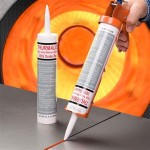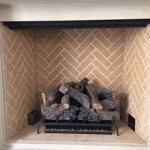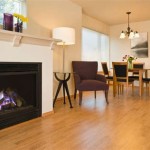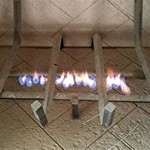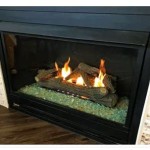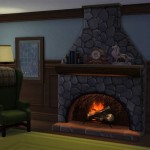Understanding Vented Gas Log Fireplaces with Blowers
Vented gas log fireplaces offer a convenient and aesthetically pleasing alternative to traditional wood-burning fireplaces. They utilize natural gas or propane to create realistic flames and provide supplemental heat. A key component that can enhance the performance and comfort provided by these fireplaces is the integrated blower system. This article aims to provide a comprehensive understanding of vented gas log fireplaces with blowers, exploring their functionality, benefits, considerations, and maintenance.
A vented gas log fireplace distinguishes itself from vent-free models by requiring a fully functional chimney or vent system. This system is essential for safely exhausting combustion byproducts, such as carbon dioxide and water vapor, to the outside atmosphere. The presence of a vent ensures a healthier indoor environment and eliminates concerns about indoor air quality that can arise with vent-free options. The visual appeal is maintained through realistic ceramic logs arranged to mimic a natural wood fire, often enhanced by glowing embers.
The inclusion of a blower significantly impacts the operational effectiveness of the fireplace. A blower, also known as a fan, is typically installed at the base of the firebox or within the surrounding mantel. Its primary function is to circulate the heated air produced by the burning gas logs into the room. This forced-air circulation dramatically improves the fireplace's heating efficiency and distributes warmth more evenly throughout the space.
Key Point 1: Enhanced Heating Efficiency
The primary advantage of incorporating a blower into a vented gas log fireplace is the substantial increase in heating efficiency. Without a blower, heat generated by the fireplace primarily radiates outwards. While radiant heat provides immediate warmth to those in close proximity, its effectiveness diminishes with distance. This results in uneven heating, with areas closer to the fireplace becoming excessively warm while other parts of the room remain relatively cool.
The blower combats this uneven heating by actively drawing cooler air from the room, passing it over the heated firebox, and then expelling the warmed air back into the space. This convective heat transfer process significantly improves the distribution of heat, ensuring a more uniform temperature throughout the room. As a result, the fireplace can effectively heat a larger area compared to models without a blower. This increased efficiency can also translate to energy savings, as the thermostat might not need to work as hard to maintain a comfortable temperature in the room.
The effectiveness of the blower is often measured by its cubic feet per minute (CFM) rating. This rating indicates the volume of air the blower can move in a minute. A higher CFM rating generally corresponds to a more powerful blower capable of heating a larger area. Selecting the appropriate blower size is crucial for optimal performance. An undersized blower will not adequately circulate the heat, while an oversized blower may create excessive noise and discomfort.
Furthermore, many blowers are equipped with variable speed controls. These controls allow the user to adjust the blower's speed and airflow to match the desired level of heating. During milder weather, a lower blower speed might be sufficient to maintain a comfortable temperature. During colder periods, a higher blower speed can provide more rapid and effective heating. This level of control enhances the user's ability to customize the fireplace's performance to suit their individual needs and preferences.
In practical terms, a vented gas log fireplace with a blower can often provide supplemental heat for a large living room or open-concept space. The consistent airflow ensures that the entire area is heated evenly, eliminating cold spots and maximizing comfort. This makes it a valuable addition to homes in colder climates or for spaces that are difficult to heat with central heating systems alone.
Key Point 2: Installation and Operational Considerations
Proper installation of a vented gas log fireplace with a blower is paramount for safety and optimal performance. It is highly recommended that installation be performed by a qualified gas technician or HVAC professional. This ensures that all gas connections are secure, the venting system is properly installed, and the blower is correctly wired. Incorrect installation can lead to gas leaks, carbon monoxide poisoning, or electrical hazards.
The venting system is a critical component of a vented gas log fireplace. It must be appropriately sized and installed to effectively exhaust combustion byproducts. A blocked or improperly installed vent can result in dangerous levels of carbon monoxide buildup inside the home. Regular inspection and maintenance of the venting system are essential to ensure its continued functionality. This includes checking for obstructions, such as bird nests or debris, and ensuring that all connections are secure.
Electrical connections for the blower must also be handled with care. The blower typically requires a standard 120V electrical outlet. The wiring should be sized appropriately to handle the blower's electrical load. It is important to ensure that the electrical outlet is properly grounded to prevent electrical shocks. If an existing outlet is not available, a qualified electrician should be consulted to install one safely.
Operational considerations include understanding the fireplace's control system. Most vented gas log fireplaces with blowers feature a remote control or wall-mounted thermostat. These controls allow the user to adjust the flame height, blower speed, and overall heating output. Familiarizing oneself with these controls is essential for maximizing the fireplace's efficiency and comfort.
Regular maintenance is also important for maintaining optimal performance. This includes cleaning the burner assembly, inspecting the gas connections, and lubricating the blower motor. A clean burner assembly ensures efficient combustion and prevents soot buildup. Regular inspection of the gas connections can help identify and prevent gas leaks. Lubricating the blower motor can extend its lifespan and reduce noise.
Noise levels associated with the blower can vary depending on the model and speed setting. Some blowers operate quietly, while others can produce a noticeable humming sound. It is important to consider the noise level when selecting a fireplace, especially if it will be used in a bedroom or other quiet space. Many manufacturers provide decibel ratings for their blowers, which can be used to compare noise levels.
Key Point 3: Design and Aesthetic Versatility
Vented gas log fireplaces with blowers offer a wide range of design and aesthetic options to complement any home décor. The realistic ceramic logs are available in various styles, sizes, and finishes to mimic different types of wood, such as oak, birch, or maple. This allows homeowners to select a log set that matches their existing fireplace mantel and surrounding furnishings.
The fireplace mantel itself can also be customized to suit individual preferences. Mantels are available in a variety of materials, including wood, stone, brick, and metal. They can be designed in traditional, modern, or contemporary styles to create a focal point in the room. The integration of the blower is often discreetly hidden within the mantel or firebox, ensuring that it does not detract from the overall aesthetic appeal.
Furthermore, many vented gas log fireplaces with blowers offer additional features that enhance their aesthetic appeal. These features include adjustable flame height, glowing embers, and decorative fire glass. Adjustable flame height allows the user to customize the intensity of the flame, creating a more dramatic or subtle ambiance. Glowing embers add realism to the fire, mimicking the appearance of burning wood. Decorative fire glass can be used to replace traditional ceramic logs, creating a modern and visually striking effect.
The flame presentation is often enhanced by the design of the burner assembly. High-quality burner assemblies are engineered to create realistic flame patterns that dance and flicker like a natural wood fire. These burner assemblies often incorporate multiple burner ports to distribute the gas evenly and create a more visually appealing flame. Some models even feature remote-controlled flame adjustments, allowing the user to fine-tune the flame height and intensity from the comfort of their couch.
The versatility of vented gas log fireplaces with blowers extends to their installation options. They can be installed in existing masonry fireplaces, as well as in prefabricated fireplace enclosures. This makes them a suitable option for both new construction and renovation projects. When installing a vented gas log fireplace in an existing masonry fireplace, it is essential to ensure that the chimney is in good condition and properly sized for the fireplace. A chimney inspection by a qualified professional is recommended before installation.
The combination of realistic flames, customizable mantels, and optional decorative features makes vented gas log fireplaces with blowers a versatile and aesthetically pleasing heating solution. They offer the warmth and ambiance of a traditional fireplace without the mess and hassle of wood-burning. The integrated blower enhances their heating efficiency, ensuring that the warmth is evenly distributed throughout the room. This makes them a valuable addition to any home seeking a comfortable and stylish heating option.

Napoleon Gl30e Vented Gas Log Set 30 Inch

Vented Gas Logs Heater Or Decorative Bart Fireside

Real Fyre R Golden Oak Vented Gas Logs

Vented Gas Logs Natural And Propane

Vented Gas Logs Freeman

Majestic Vdy Duzy Series Vented Gas Log Set

Hargrove Inferno See Through Shallow Vented Gas Log Set With System 4 Burner Propane Specialized Hgissss S4b

Fiberglow 18 Gas Log Set Natural Electronic Ignition

Real Fyre W White Birch Vented Gas Logs

Pleasant Hearth Wildwood 18 Dual Fuel Vent Free Gas Log Set 30 000 Btu Com
Related Posts


